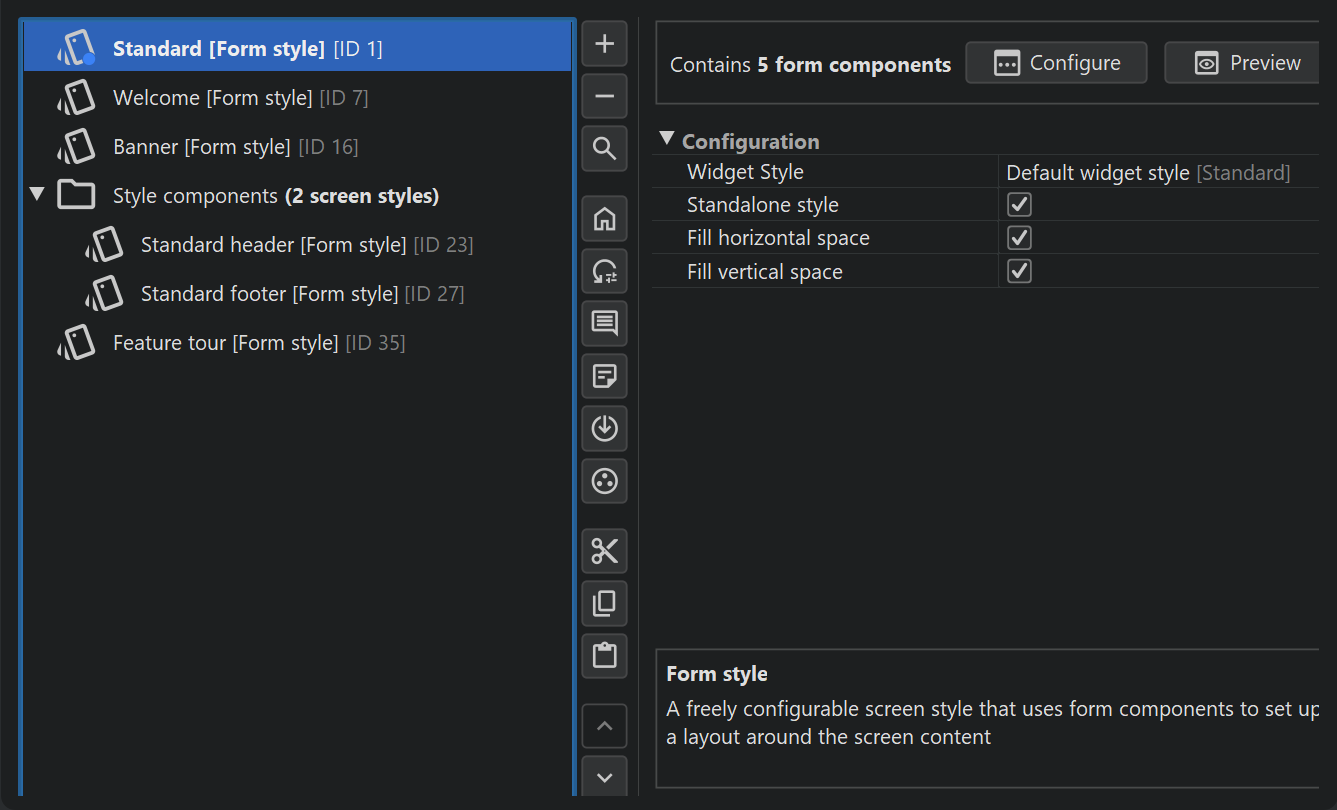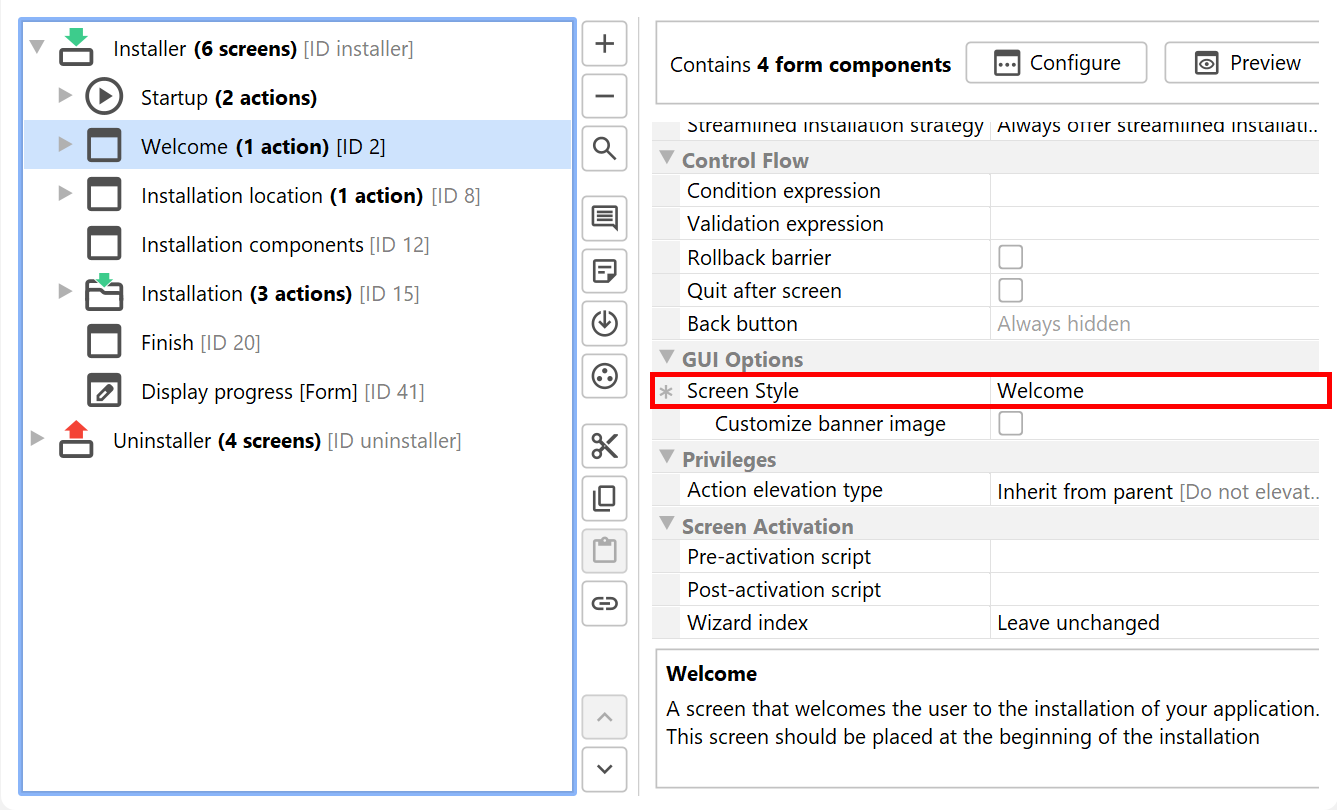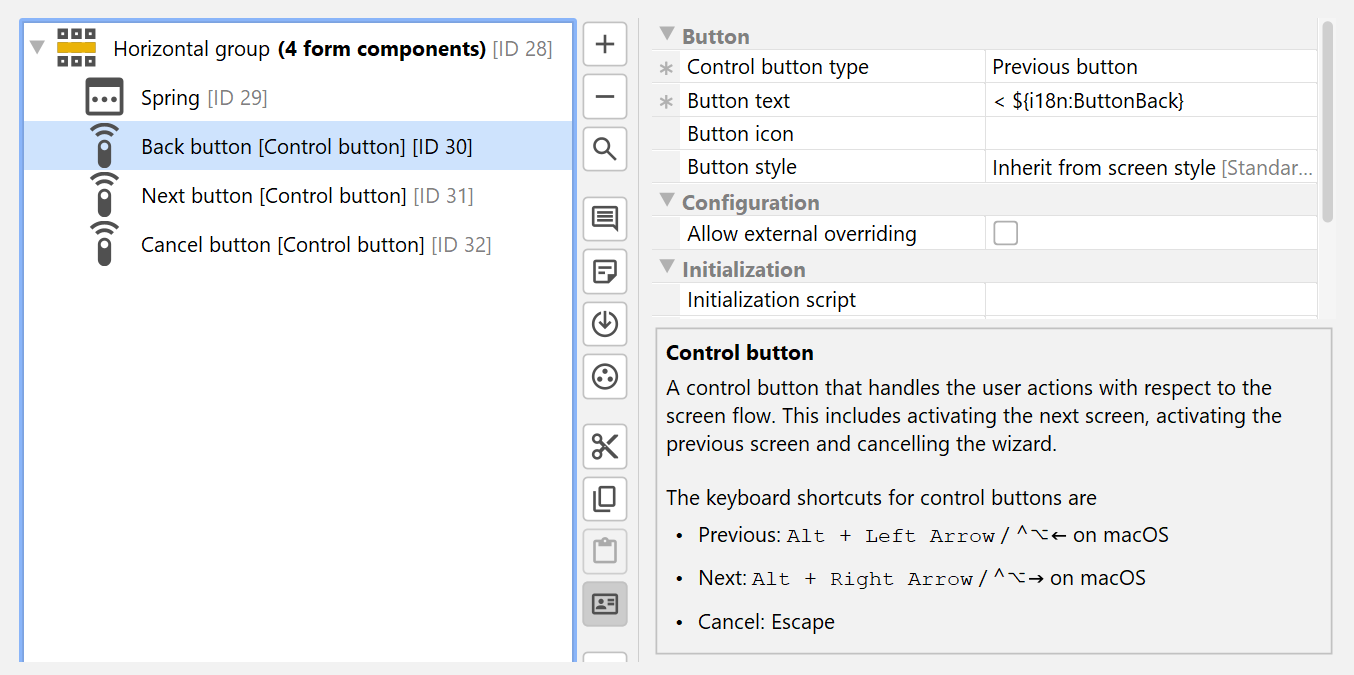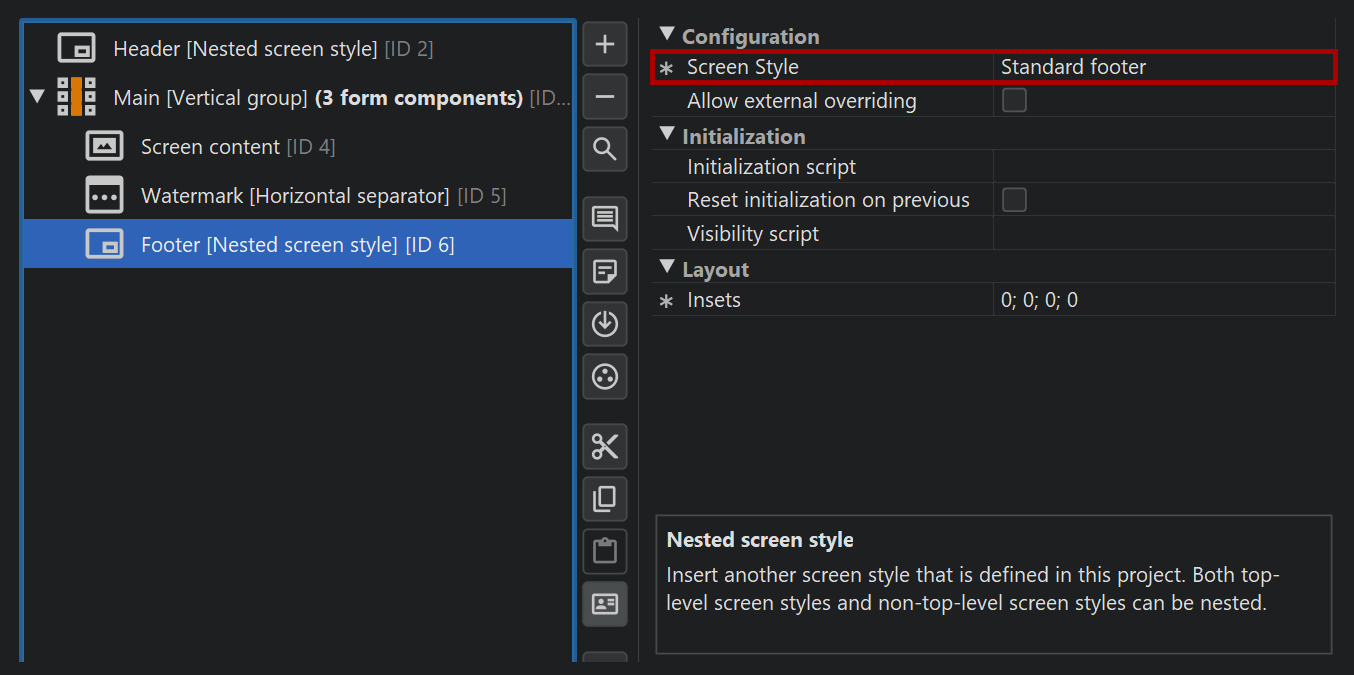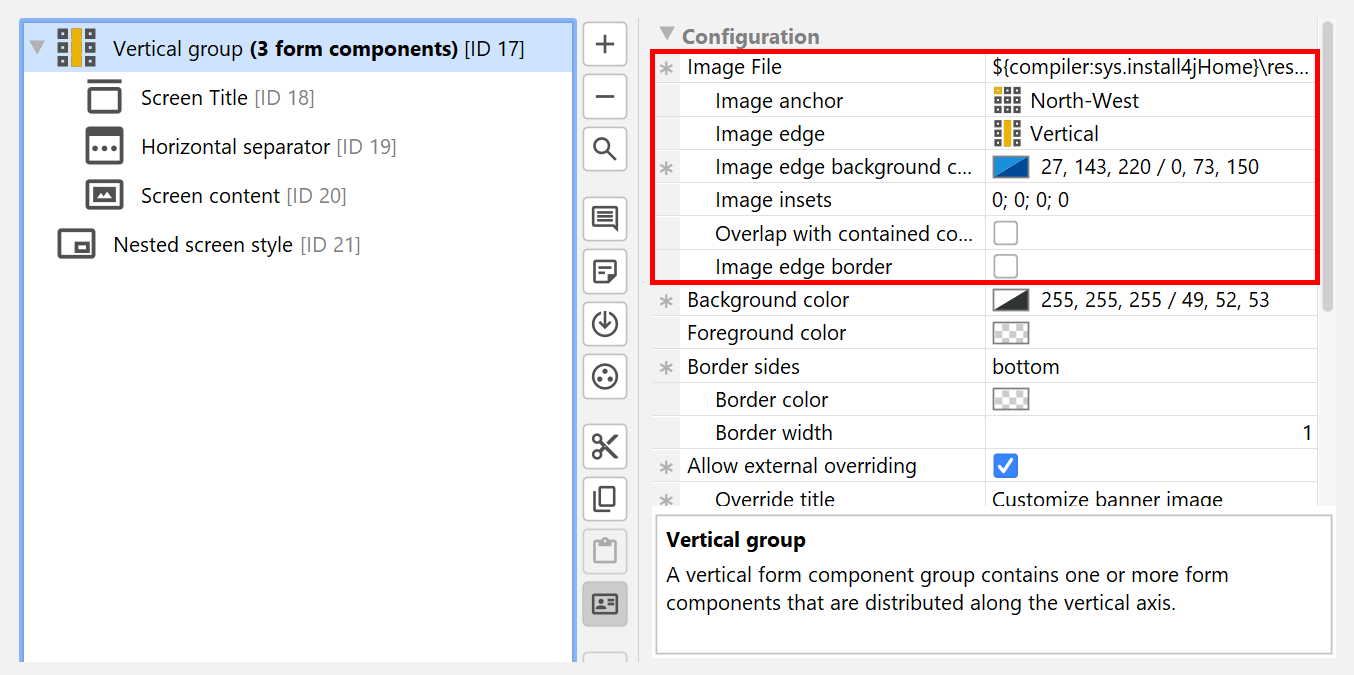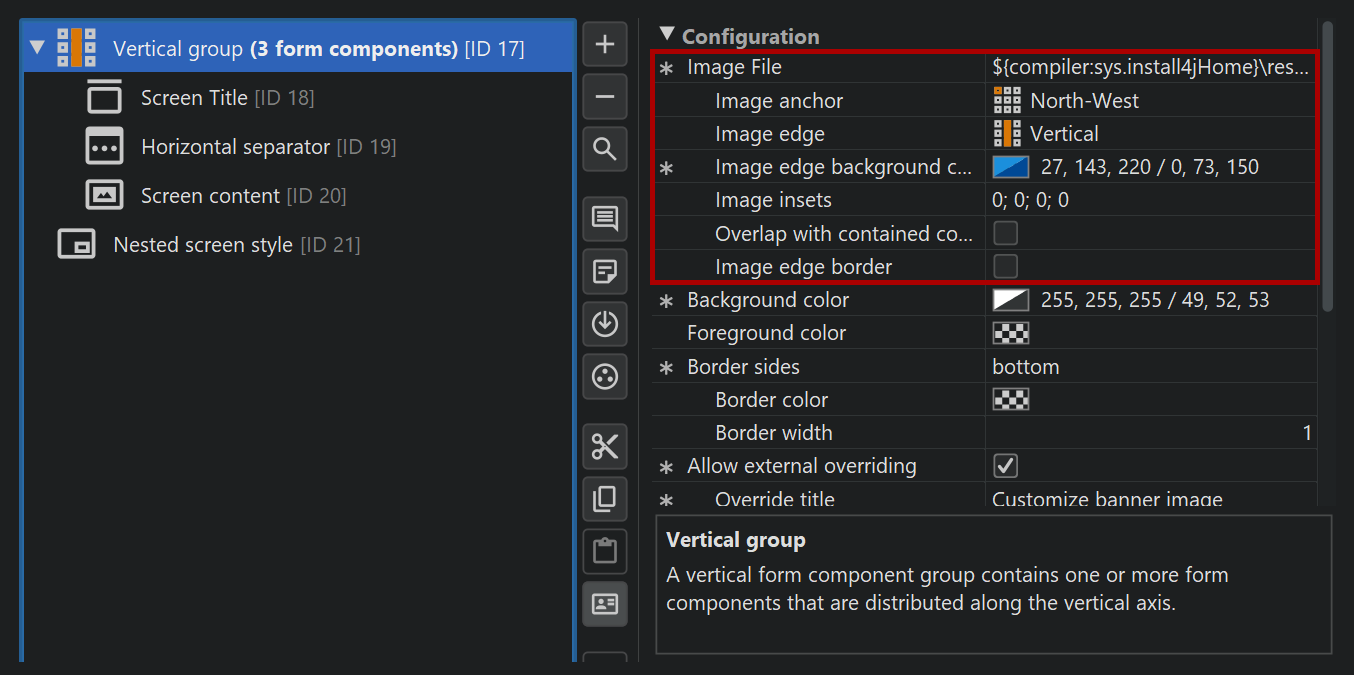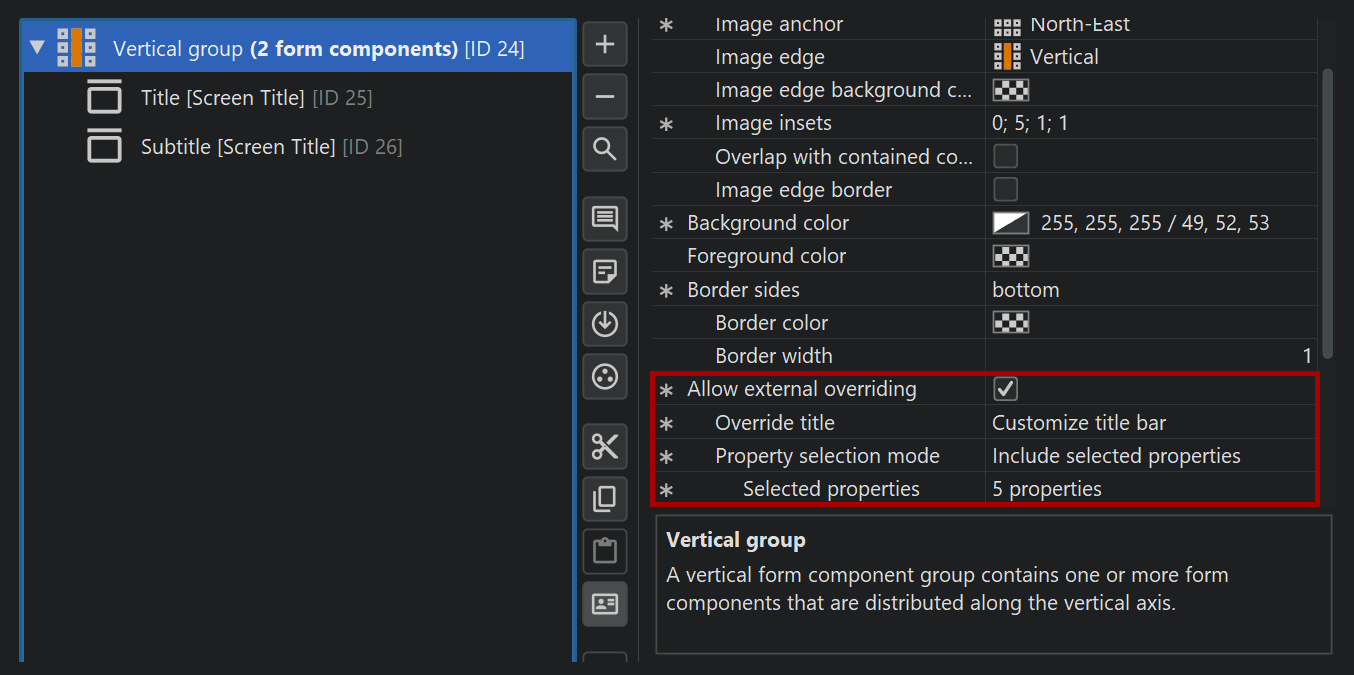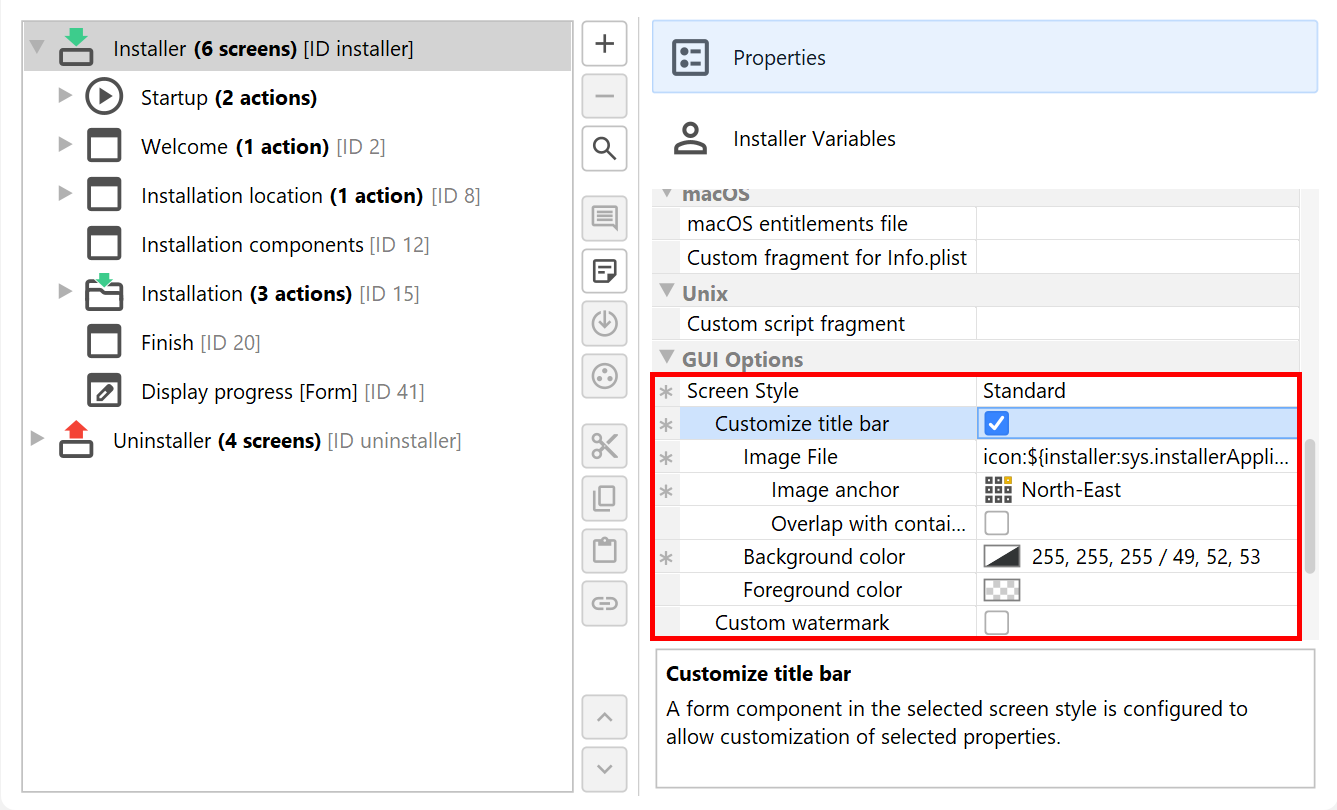Install4j has a flexible model for styling the UI of installer applications that allows you to arrange content and styling elements in arbitrary ways. While there is an API to do this programatically, you can configure form screen styles in the install4j IDE without any custom code. Form screen styles use the same foundation as form components for screens. All default screen styles are created with form screen styles, so the details of the default screen styles can we tweaked very easily and new screen styles can be developed by starting with the default styles.
Configuring screen styles
Screen styles are configured on a per-project basis. On the "Installer->Screens & Actions->Styles" step of the install4j IDE, all available screen styles are listed. When you add a screen style, it can either be a configurable form screen style, or a screen style implementation from your custom code. Styles are either standalone or not. A non-standalone screen style cannot be used directly, but is only available for nesting into other screen styles.
One single screen style is marked as the default screen style and is shown with a bold font. With the "Set As Default" action, you can change the default screen style. Styles can be grouped into folders for organizing them according to your individual preferences. For example, in the default screen styles, the nested screen styles are grouped into a separate folder whereas the standalone screen styles are located at the top level.
On the "Installer->Screens & Actions" step of the install4j IDE, you can apply screen styles. Installer applications, screen groups and screens all have a "Screen Style" property. For installer applications, this property is set to "Default". You can change it to any standalone screen style. For screen groups and screens, the "Screen Style" property is set to "Inherit from parent". The property also indicates which screen style is actually inherited. Alternatively, you can choose to explicitly set a screen style for the selected element. Any screen groups and screens below it will now inherit this screen style.
Some screens have a preference for a particular screen style. For example, the "Welcome" and "Finish" screens want their screen style set to "Banner". When adding such a screen, the IDE matches the screen style by name. In this example, if no screen style named "Banner" is available, the default screen style is used. Otherwise, install4j keeps track of screen style associations by ID and you can rename screen styles without breaking any associations.
If you delete a screen style, all its screen style associations are broken. Compiling the installer will now fail, and you will have to visit all installer applications, screen groups and screens where this screen style was explicitly selected and choose a new screen style.
Should you want to return to the default screen styles, there is a "Reset Screen Styles To Default" action for that purpose. Existing screen style associations are matched by name in that case, so screen style associations with the "Banner" screen style survive this reset, for example.
Form Screen styles
A restricted set of the form components that are available for building form screens can be used to build form screen styles. Form components that take user input are not suitable for screen styles because screen styles have a different life-cycle than screens.
In addition, form screen styles can use a set of special form components. The "Screen content" form component contains the UI component of the screen and is changed each time when a screen is activated. When you preview the screen style, this content area is shown with a placeholder. The "Screen Title" form component shows the title or the subtitle of the screen, depending on its "Title type" property. The "Control button" form component is used for realizing the "Next", "Previous" and "Cancel" buttons.
Finally, the "Nested screen style" form component allows you to embed another screen style. In this way, you can build a set of screen styles that share common parts. For example, in the default screen styles, the navigation buttons at the bottom are the same. With the "Standard Footer" screen style used by both the "Standard" and the "Banner" standalone screen styles, you have a single place to change its settings.
Graphical styling elements
A key concern of styling is the placement of images, either in the foreground or in the background. Both kinds of placements are handled by layout groups in form screen styles. For both vertical and horizontal form groups, setting their "Image file" property shows additional properties that allow you to place the image in the layout group. If you place the image in the foreground, it cuts off an entire edge of the rectangle that can get its own background and border. In that way, the image can blend seamlessly into its surroundings.
To place an image into the flow of form components, you can use the "Image insets" property and set its "Icon" property.
Other important styling elements are borders and separators. Again, this is handled by layout groups. With their "Border sides" property, you can define which sides of the border should be drawn. Color and thickness of borders are also configurable.
By default, layout groups and form components are transparent, so that the default background color of the window shines through. By setting the "Background color" property of a layout group, you can make it opaque and give it a specific color. The "Foreground color" property sets the font color for contained form components that do not have their color set explicitly.
Overriding properties
Some screen styles can have elements that are specific to particular screens or particular installer applications. For example, the header image in the "Standard" screen style or the banner image of the "Banner" screen style could be required to change for each screen. Instead of duplicating screen styles in this scenario, install4j allows you to designate certain properties of selected form components and layout groups that should be overridable when the screen style is applied.
When editing the form components of a form screen style, each form component has an "Allow external overriding" property. If you select that property, a named overriding entry will be offered when you explicitly apply the screen style on the "Installer->Screens & Actions" step. With the "Override title" property, you specify the displayed name for the override entry, and that name is used for saving the overridden properties. This means that the name must be unique for a single screen style and that overrides are lost if you change the name. The "Property selection mode" property then lets you select which properties should be overridable, either all properties are overridable, or a list of properties is included or excluded.
When you select a screen style on the "Installer->Screens & Actions" step, install4j scans the screen style and all its nested screen styles for form components and layout groups with defined overrides. Each named override is presented as a checkbox property. If you select the checkbox, the overridable properties of the form component or layout group are copied and displayed as child properties. You can now change the properties to different values. Note that the overridable properties lose their connection to the default values in the original form component or layout group. If you change a default property value, you have to manually change it in all overrides, if necessary.
For more complex overriding cases, consider adding a "Nested screen style" form component and making its "Screen Style" property overridable. When applying such a screen style, you can substitute a different nested screen style as appropriate.
API
Under some circumstances, screen styles are more easily implemented with the API. For example, if you want to have configurable properties that determine the construction of the screen style or if the styling cannot be realized with the facilities of the form screen style.
The sample project "customCode" includes a screen style class SunnySkyBackgroundStyle and
its associated BeanInfo SunnySkyBackgroundStyleBeanInfo that show such an example screen style.
It paints a background image that depends on the window dimensions and continues up to the window border.
In the "customCode" project, look for the "Configurable form" screen in the installer and preview the
form to see what it looks like.
That example also shows how to implement a screen style that wraps a user-selectable screen style. The main screen style is still
the standard screen style, and the "Sunny sky background" screen style takes the function of a decorator. To make development
of such wrappers easier, the API includes a convenience class com.install4j.api.styles.WrapperStyle.
Merging screen styles from other projects
Instead of duplicating screen styles across projects, you can develop them in one project and merge them into other projects. The merge projects functionality in install4j includes an option to merge styles.
If styles are merged, the "Screen Style" property of installer applications, screen groups and screens shows the merged screen styles as well, with their names prefixed with the project name that was assigned in the merge settings.
If you link to screens or screen groups of merged projects, they will use their configured screen styles from the merged project only if style merging is enabled. Otherwise, install4j tries to match a screen style by name in the main project.
Overriding standard icons
If you would like to change the standard icons in the installer, have a look at the JAR file
resource/i4jruntime.jar in the install4j installation directory. The package
com.install4j.runtime.installer.frontend.icons contains all icons that are used by the installer.
To replace some or all of these icons with your own version, create a JAR file that contains just the new icon
files in the same directory and add it on the "Installer->Screens & Actions->Custom Code" step. The installer
will first try to load an icon from the custom code. Failing that, it will fall back to the built-in version.

